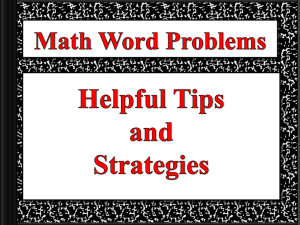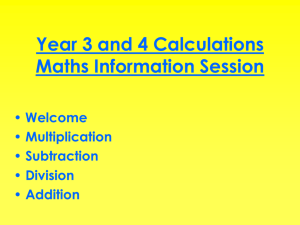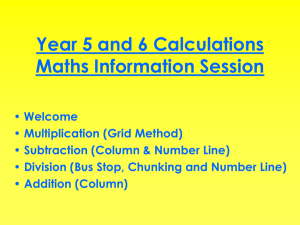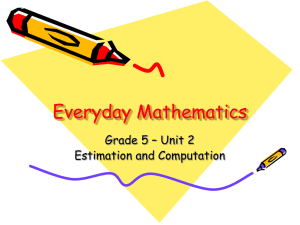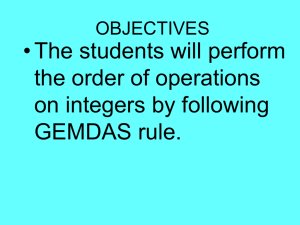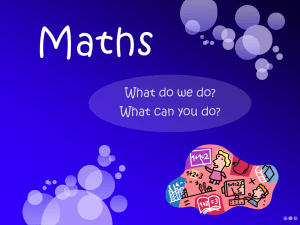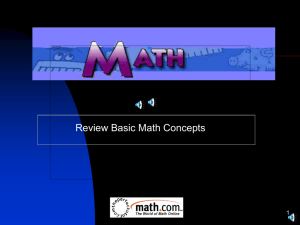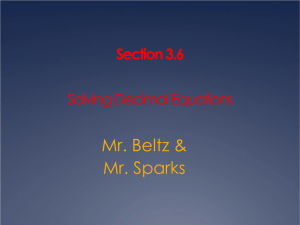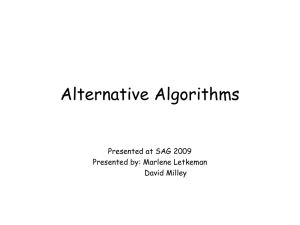Mathematical Relationships
advertisement
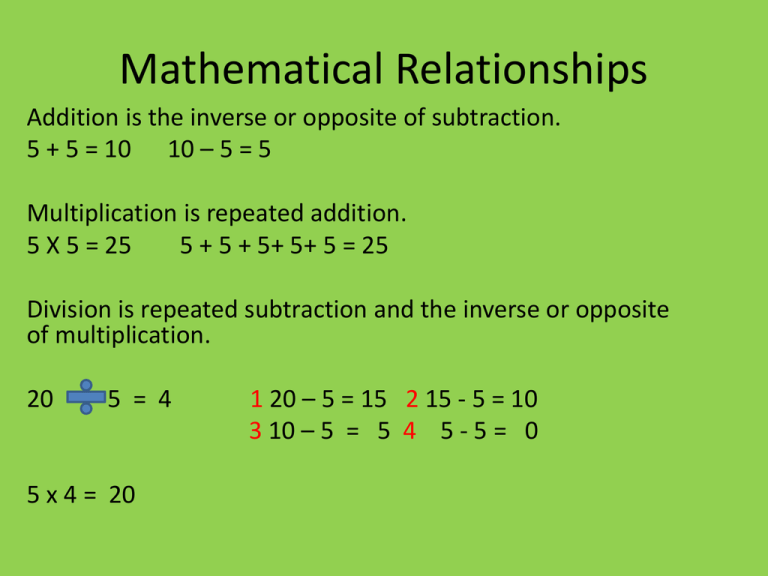
Mathematical Relationships Addition is the inverse or opposite of subtraction. 5 + 5 = 10 10 – 5 = 5 Multiplication is repeated addition. 5 X 5 = 25 5 + 5 + 5+ 5+ 5 = 25 Division is repeated subtraction and the inverse or opposite of multiplication. 20 5 = 4 5 x 4 = 20 1 20 – 5 = 15 2 15 - 5 = 10 3 10 – 5 = 5 4 5 - 5 = 0 Division Symbols • Remember that Math is a language. Therefore the symbols that we use have meaning. The following symbols all mean divide by or represent division. • x y x x y • y Hint: All of these division symbols are read as x divided by y. The variables x and y can represent any number. Multiplication concepts • Represent 4 X 3 as a model • We read this math sentence as 4 groups of three. • Represent 3 X 4 as a model • How is this different from 4 x 3? Division Concepts • Represent 12 3 as a model • We read this math sentences as 12 divided by three or four groups of three. • Represent 12 • from 4 as a model How is this different than 12 divided by 3? Multi-digit Multiplication • Use a model to show 12 X 4. • This means 12 groups of 4. • This could also be a model for 48 4 Traditional method 12 x4 48 We can look at this at 12 groups of 4, but using the algorithm we first multiply 4 x 2 and get 8 ones. Then we multiply the 4 x the 1 ten to get for tens. We then add the 40 or 4 tens plus 8 ones to get 48. Traditional method How does the algorithm look if we have multi-digits numbers on both top and below? 1 48 X 12 96 1 +480 576 What is happening here? We are asking what is 12 groups of 48. The tricky part here is remembering how this ties back to our models and place value. Solve Use the Traditional method and a model 253 x45 452 x 76 25 x4 Long Division or Magic Seven • When we are dividing we are asking how many times one quantity can go into another quantity. • If the quantity that we are dividing into is larger than the quantity we are dividing by we end up with an answer greater than 1. • If the quantity that we are dividing into is less that the quantity we are dividing by we end up with an answer that is less than one (decimal or fraction). Long division and Magic 7 • What we are asking is how many 20 are in 1000. • 50 20 1000 -100 00 - 0 0 50 20 1000 - 400 600 - 400 200 - 100 100 - 100 0 20 20 5 + 5 50 Subtraction in the division and Magic 7 • Did you notice in both algorithms whether it was Magic 7 or Long division they involved subtraction. This shows the relationship between division and subtraction. • Did you notice that by taking the answer from a division problem and multiplying it by the quantity you divided this you end up with the number you were dividing into. This explains the relationships between multiplication and division. Solve using either Magic 7 or division . 26 320 . . 320 26. What is the difference between these two. One results in a number less than one and one results in an answer greater than 1. Why? The decimal number is always present even if it is not written it is inferred that it is there. Practice 45 627
